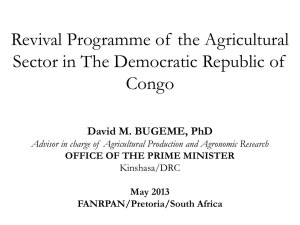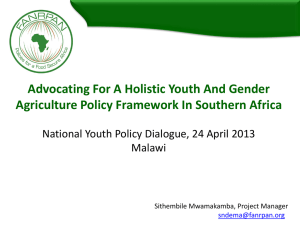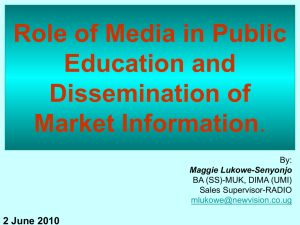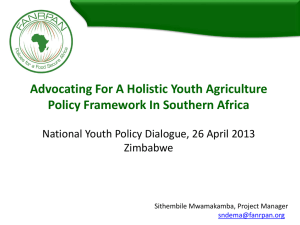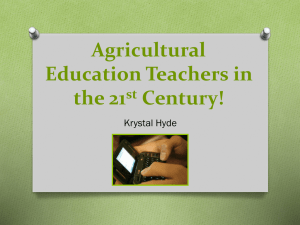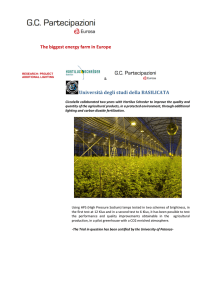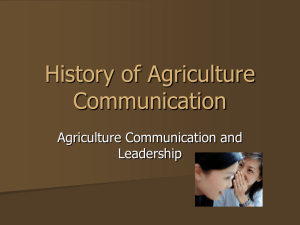Zimbabwe Country Case Study Presentation (2.7Mb ~ 8
advertisement
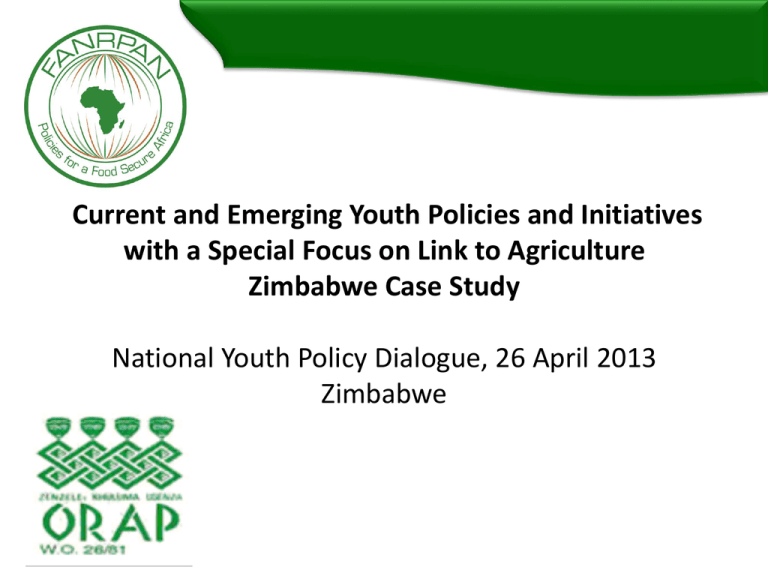
Current and Emerging Youth Policies and Initiatives with a Special Focus on Link to Agriculture Zimbabwe Case Study National Youth Policy Dialogue, 26 April 2013 Zimbabwe TOPICS TO BE COVERED • • • • • • • • Research questions Zimbabwe’s agricultural context Zimbabwe’s agricultural zones Regional differences and their importance Youth perceptions of agriculture Policy review highlights The Holistic view of agriculture Opportunities for youth engagement Food, Agriculture and Natural Resources Policy Analysis Network (FANRPAN) www.fanrpan.org RESEARCH QUESTIONS • What are the perceptions held by young people regarding agriculture? • Are governments doing enough to incentivise youth involvement in all aspects of agricultural production ? • How have the youth organised themselves in the agricultural sector? • What are the dynamics colouring the relationship between rural and urban youth within this context? • What is the extent of institutional and organisational support available to young people? • Do any symbiotic synergies exist between youth in agriculture and other spheres of the economy? Food, Agriculture and Natural Resources Policy Analysis Network (FANRPAN) www.fanrpan.org ZIMBABWE’S AGRICULTURAL CONTEXT • Unique case study because land reform centralised the issue of agriculture between 2000-2008 • Agricultural sector provides income for approx. 70% of pop. • Provides 60% of the raw materials for industrial sector • 40% total export earning, contributing 15-19% of GDP • 57% of the population is between 18-35 (2010 estimate) Food, Agriculture and Natural Resources Policy Analysis Network (FANRPAN) www.fanrpan.org Highly dualistic agricultural sector • commercial sector, land is privately owned, production is for the market and farms are run as commercial profit-seeking enterprises. • smallholder sector, households do not have title to the land they farm, much of the production activity is family-based and subsistence production remains an important part of livelihood strategies. Food, Agriculture and Natural Resources Policy Analysis Network (FANRPAN) www.fanrpan.org • The mass transfer of arable land directly meant that in the past decade thousands of young people have received or have access to land for both commercial and subsistence agriculture. Therefore ASSUMPTION-> HIGH YOUTH INVOLVEMENT IN AGRICULTURE Food, Agriculture and Natural Resources Policy Analysis Network (FANRPAN) www.fanrpan.org ZIMBABWE’S AGRICULTURAL ZONES Food, Agriculture and Natural Resources Policy Analysis Network (FANRPAN) www.fanrpan.org REGIONAL DIFFERENCES AND THEIR IMPORTANCE • Based primarily on average quantities of rainfall and their variability, these ‘natural regions’ provide a broad framework for evaluating whether the difference in agricultural activity affects youth perspectives, organisation and policy implementation. • zones I & II: highest agricultural productivity, levels of organisation, institutional support • zones IV & V: lowest agricultural productivity, mainly subsistence farming, alternative economic processes • NB. Because different agricultural environments different youth cultures and perceptions on agric. Food, Agriculture and Natural Resources Policy Analysis Network (FANRPAN) www.fanrpan.org YOUTH PERCEPTIONS ON AGRICULTURE • differentiated nature of agricultural production across the various provinces in the country has led to uneven levels of participation in agriculture. • Young people in areas of high agricultural growth are likely to be more interested in making farming a central element of their livelihood than those living in low growth areas. • the main difference is in the way they view agriculture in relation to the wealthcreation vs. subsistence models • Rural youth: have limited access to information, resources and technical expertise and so perceive and partake in farming mainly as a subsistence activity. • Urban youth: have wider scope to commercialise their agricultural endeavours, easier access to credit, technical support etc. Food, Agriculture and Natural Resources Policy Analysis Network (FANRPAN) www.fanrpan.org • Status and prestige play pivotal role in the way young people form their aspirations and perceive agriculture. Agriculture in general needs to ‘rebranded’ to young people to change the perception that it is a ‘last resort’ activity. • Humanitarian and aid agencies- Although it is an essential part of drought relief, merely handing out food potentially creates dependent relationships which disincentivise young people from agriculture (parent perspectives) • Youth feel disempowered in the policy formulation stage, they haven’t organised themselves in a way that they can lobby government. • Lack of a coordinated demographic-specific policy framework means many youth are focusing on self-help Food, Agriculture and Natural Resources Policy Analysis Network (FANRPAN) www.fanrpan.org POLICY REVIEW HIGHLIGHTS • Agricultural policies- broad and macro-level, not specific to youth, implementation limited by lack of tenure clarity etc • National Youth Policy- very wide in scope, but regarding agriculture it emphasises training, land provision, access to credit and education and skills development, enhancing the attractiveness of the rural areas • Disparity between policy formulation and implementation • standard assumption on the policy side that ‘youth’ will play their part- i.e. apply for loans, organise themselves etc, without cognisance of education and so on. Food, Agriculture and Natural Resources Policy Analysis Network (FANRPAN) www.fanrpan.org • In light of all these issues then, what are the opportunities for youth to engage in the agricultural value chain in Zimbabwe? Food, Agriculture and Natural Resources Policy Analysis Network (FANRPAN) www.fanrpan.org CHALLENGES FACED BY YOUTH • Limited access to finance/ inadequate training / broad and ineffective policy frameworks from government/ poor lobbying capacity and organisation among the youth themselves/ inefficient infrastructural and logistical access and support, and so on. • lack of contextualised policies for different agricultural zones. 1. Different agricultural zones specialise in different agricultural methods and products, BUT are governed by a ‘one-size-fits-all’ policy approach. • Therefore, young people are creating alternative spaces of economic participation (small scale mining/cross-border trading/hunting and poaching/and other ‘quick-return, high-risk’ activities in the areas without adequate agricultural support. Food, Agriculture and Natural Resources Policy Analysis Network (FANRPAN) www.fanrpan.org CONTEXTUALISING OPPORTUNITIES: THE HOLISTIC VIEW OF AGRICULTURE • Definitional focus on agriculture as limited to primary production • To understand the value-chain and where they can participate, youth must ‘re-brand’ and modernise their definition of agriculture. • Identifying the symbiotic synergies between agriculture and other sectors helps enable youth to engage and participate in the valuechain more proactively. • Holistic view of agriculture leads to a better appreciation of available opportunities, because regardless of sector we can see the links to agricultural value-chain. Food, Agriculture and Natural Resources Policy Analysis Network (FANRPAN) www.fanrpan.org Agricultural value chain example 1) Input/supply 3) storing 2) producing Food, Agriculture and Natural Resources Policy Analysis Network (FANRPAN) 5) marketing 4) processing www.fanrpan.org OPPORTUNITIES FOR VALUE-CHAIN ENGAGEMENT BY YOUTH • The holistic approach to agriculture creates a wide range of opportunities in different fields: Engineering (support and extension to primary producers etc) Pharmaceuticals (veterinary support) agro-chemicals (fertilisers, pesticides etc) processing and marketing (packaging, selling etc) infrastructure and irrigation dev. (transport and logistics etc) ‘green’ technologies (bio-diesels, alternative energy etc) ICTs (social media, GIS, modern training techniques/support etc) banking and finance (cooperatives, micro-lending, MPESA etc) R & D (new innovations in all fields above etc) Agro-tourism (the next frontier that youth can champion?) and so on.... • promoting greater sectoral linkages, value-chain development enhances job creation and agricultural modernisation in Zim/ Africa Food, Agriculture and Natural Resources Policy Analysis Network (FANRPAN) www.fanrpan.org RECOMMENDATIONS • Agricultural education must be modernised and prioritised • Contextualised policy prescriptions, rooted in evidence based research of the needs and requirements of young ‘agripreneurs’ are essential • Finding creative ways to make access to capital easier (with adequate training and support, youth not as financially risky) • Replication and reward of success stories • Modern ICT methods of business and information dissemination must be tapped into • Climate change awareness and adaptive farming techniques to ensure sustainability Food, Agriculture and Natural Resources Policy Analysis Network (FANRPAN) www.fanrpan.org Thank you Siyabonga Tatenda Food, Agriculture and Natural Resources Policy Analysis Network (FANRPAN) www.fanrpan.org
